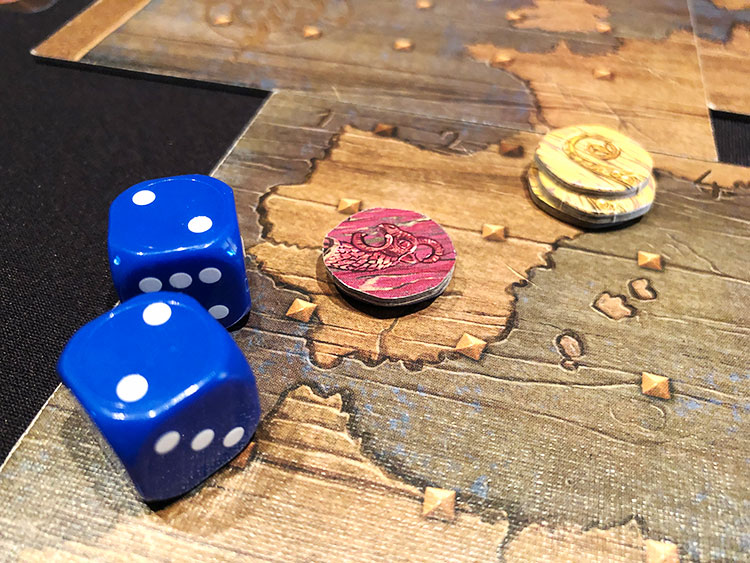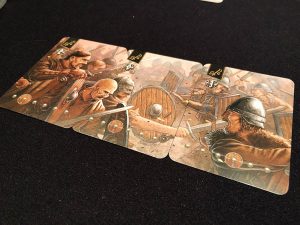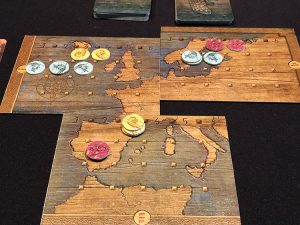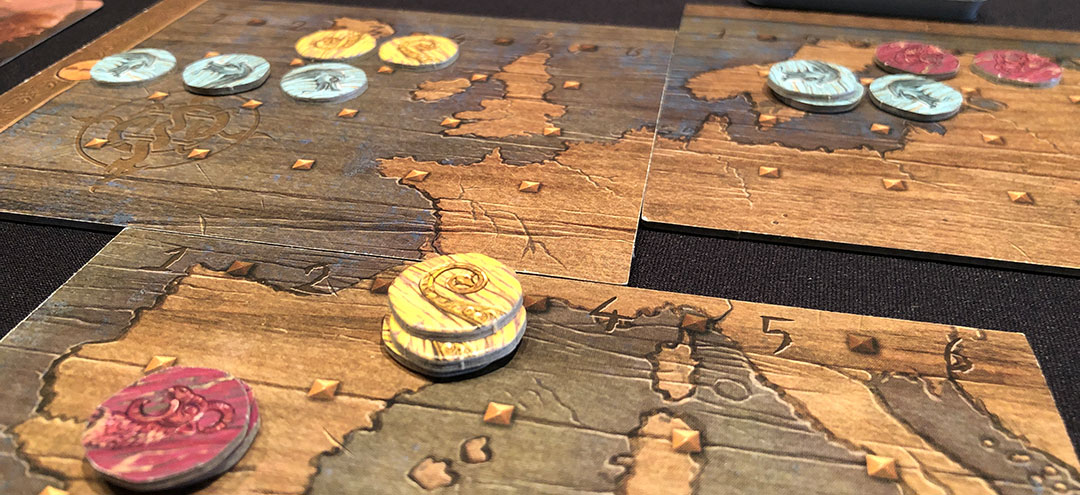 Back in the 700s, the Abbey of Lindisfarne is sacked and the West discovered the existence of Vikings…fierce warriors that raid the coasts up and down the continent. In Lindisfarne, you take on the role of a Jarl sending out your raiders into Europe to bring back treasure and prestige.
Back in the 700s, the Abbey of Lindisfarne is sacked and the West discovered the existence of Vikings…fierce warriors that raid the coasts up and down the continent. In Lindisfarne, you take on the role of a Jarl sending out your raiders into Europe to bring back treasure and prestige.
That’s the theme of this small box game from Eagle-Gryphon Games. Lindisfarne is a dice rolling, set collection game for 2-4 players that definitely plays best with 3 players. So, grab your horn of mead as we check out this game of dice rolling and card drafting.
Gameplay Overview:
Each turn in Lindisfarne will have you rolling dice and placing them on one of three boards of Europe. At the start of the round, you have six dice to roll, yet as you place dice, you’ll have fewer and fewer to place, until you must return to your homeland.
On a player’s turn, they roll all their remaining dice and must place any of the results on one of the three boards. You can place a few as one die or as many as 6. Each board will score in a different way at the end of the round. One board wants the highest total sum of your dice, another wants the longest straight of numbers, while the third wants the most of the same number.
Whichever player wins the board will get the first choice of one of the two destination cards. These will score points for the player via set collection rules. After the winner chooses their spoils, then the runner up gets to pick from the leftovers.
Players will repeat this process for 6 full rounds, with the winner being chosen after the end game scoring points are awarded.

Game Experience:
I’ve had to put off writing my review of Lindisfarne for quite a while now. While I’ve managed to get in some game nights, most have been with only two players. After giving Lindisfarne a go with two, I highly suspected that this was not the best player count for it… And it turns out I was right. This is one of those games where you really want at least 3 players. That’s because, at its heart, Lindisfarne is an area control game. And as with most area control games, the more players jockeying for position the more interesting the game becomes.
That being said, the two-player rules are… fine. There is a dummy player that goes first in the round to block a few spaces, but it’s completely random and no substitute for a real player. Frankly, if your primary size is 2p, look elsewhere for dice rolling fare.

Yet if you can get a full player count, Lindisfarne can be a good time. The dice-rolling mechanics work well and lead to some tense moments. The game has an almost wagering feel to it as you need to add dice to the board, not knowing if you will win it. Sure, you could go all in and commit all your dice to one board, guaranteeing you’ll win first prize, but then you are basically giving up on collecting more than one card that round. So, every turn becomes a decision point of not only which board to commit your dice to, but how many dice.
The other interesting thing is that ties are broken by the order in which players put their first die on a board. So, players who committed sooner will have a better shot at the best loot. And because players are capped at 6 dice per round, some boards may only have 1-2 dice placed, making tiebreakers pretty important. Overall, the dice system was fun, interesting, and full of solid decision making.
Where Lindisfarne falters a little is with its scoring cards. There is really just too much going on here. Every card is going to score you from 0-2 points. But also, potentially be part of a mural that will give you points on a sliding scale. Then there are points for having the most of each of the six colors. Oh, and you can also grab objective cards that give you points for having sets of 3 specific colors. And I haven’t even gotten into the special cards that give one-time bonuses or end game victory powers. It was just too much and muddied the waters of an otherwise streamlined game.

Finally, let’s talk about the components. Overall, the presentation her his good. The art is well done, and the theme works even if it’s pasted on. The small box size feels right for this game and helps to make it fairly portable. Although I really hate how they did the game board. It’s a weird amalgamation of spaces and offset placement. Why, just why!?
But the biggest issue is with the crappy rulebook. I had a rough go at learning the game and ended up watching a video online. It just doesn’t do a very good job explaining the rules and really needed some help clearing up edge cases.
Final Thoughts:
Lindisfarne gameplay makes for a solid play experience, even if it’s held back by its poor rulebook and overly complicated scoring system. The dice rolling system is pretty great, leading to lots of interesting decisions to make and tense moments. Overall, the only time we felt held back by the results of the dice was at the very end of a round when we were down to our last die or two. While Lindisfarne may not be wholly unique, what it does do it does well. If you are looking for a portable, dice rolling game, this one could be worth a look.
Final Score: 3.5 Stars – A set collection and dice rolling game that also sneaks in a little bit of press your luck.
 Hits:
Hits:
• Fun dice mechanics
• Highly portable
• Good decision making and tense moments
Misses:
• Rulebook could use some help
• I hate that game board






















